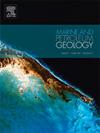Tectonic controls on the submarine Scoglio d’Affrica mud volcanoes (Northern Apennines hinterland)
IF 3.7
2区 地球科学
Q1 GEOSCIENCES, MULTIDISCIPLINARY
引用次数: 0
Abstract
Four submarine mud volcanoes were discovered in the northernmost Tyrrhenian Basin, Italy, following the eruption of one of them in 2017 near the Scoglio d’Affrica Islet. The eruption occurred a few months after a seismic sequence that hit central Italy (Mwmax 6.5–6.6). Although the peak dynamic stresses estimated at the eruption site are not high enough to confidently substantiate a cause-effect link, they possibly contributed to triggering a delayed response of the mud volcano. These mud volcanoes, along with several pockmarks, lie on top and at the margins of a morpho-structural high known as the Elba-Pianosa Ridge (EPR). The structural setting of the EPR plays an important role in the storage and subsequent upward migration of deep-sourced fluids. However, there is no consensus on the tectonic setting of this feature, and different models have been proposed. We have undertaken a structural-geological study integrating data from (1) wellbores drilled in proximity of the mud volcanoes, (2) the CROPM12A seismic reflection profile, which crosses the EPR near the mud volcanoes, and (3) structural data collected on the Island of Pianosa, an emerged portion of the EPR. The results support the hypothesis that the EPR corresponds to an antiformal stack structure bounded by high-angle normal faults at its margins. Wellbore data indicate the presence of significant overpressures associated with an increase in hydrocarbon gases in the core of the antiform, which suggest the existence of a deep-seated fluid reservoir. The pressurised fluids leak from the reservoir and move upwell capitalizing on a complex network of interconnected brittle planar features (i.e., thrust and normal faults, fractures), reaching both the culmination and the margins of the EPR. The lesson from this study is that mud volcanoes can also form in the innermost part of a thrust belt, where compressional stresses have long since faded. Inactive anticlines still have the capacity to collect and pressurise deep-sourced fluids, which can accumulate into the fold core and ultimately generate mud volcanoes.
构造对非洲斯科利奥海底泥火山(亚平宁山脉北部腹地)的控制
在意大利最北端的第勒尼安盆地发现了四座海底泥火山,其中一座于2017年在Scoglio d ' africa岛附近喷发。这次火山喷发发生在意大利中部地震序列(最高6.5-6.6级)几个月后。虽然在喷发地点估计的峰值动态应力不足以确定因果关系,但它们可能导致泥火山的延迟反应。这些泥火山,连同几个麻坑,位于一个被称为厄尔巴岛-皮亚诺萨山脊(EPR)的形态结构高地的顶部和边缘。EPR的构造背景对深源流体的储集和随后的向上运移起着重要作用。然而,对于该构造的构造背景尚未达成共识,并提出了不同的模式。我们进行了一项结构地质研究,整合了以下数据:(1)在泥火山附近钻探的井眼,(2)穿过泥火山附近的EPR的CROPM12A地震反射剖面,以及(3)在EPR的一个新部分皮亚诺萨岛收集的结构数据。结果支持了EPR对应于一个由边缘高角度正断层包围的反形式叠层结构的假设。井眼数据表明,反形体核心存在明显的超压,并伴有碳氢气体的增加,这表明存在深部流体储层。压力流体从储层中泄漏,并利用相互连接的脆性平面特征(即逆冲断层和正断层、裂缝)的复杂网络向上运移,到达EPR的顶点和边缘。这项研究的教训是,泥火山也可以在冲断带的最深处形成,那里的挤压应力早已消失。不活跃的背斜仍然有能力收集和加压深层流体,这些流体可以积聚到褶皱核心,最终形成泥火山。
本文章由计算机程序翻译,如有差异,请以英文原文为准。
求助全文
约1分钟内获得全文
求助全文
来源期刊

Marine and Petroleum Geology
地学-地球科学综合
CiteScore
8.80
自引率
14.30%
发文量
475
审稿时长
63 days
期刊介绍:
Marine and Petroleum Geology is the pre-eminent international forum for the exchange of multidisciplinary concepts, interpretations and techniques for all concerned with marine and petroleum geology in industry, government and academia. Rapid bimonthly publication allows early communications of papers or short communications to the geoscience community.
Marine and Petroleum Geology is essential reading for geologists, geophysicists and explorationists in industry, government and academia working in the following areas: marine geology; basin analysis and evaluation; organic geochemistry; reserve/resource estimation; seismic stratigraphy; thermal models of basic evolution; sedimentary geology; continental margins; geophysical interpretation; structural geology/tectonics; formation evaluation techniques; well logging.
 求助内容:
求助内容: 应助结果提醒方式:
应助结果提醒方式:


